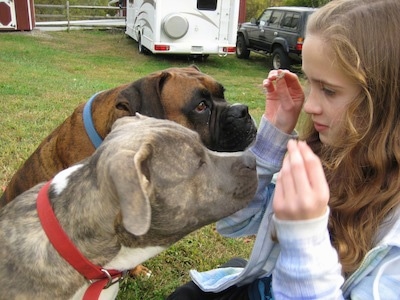
We hear a lot about positive reinforcement training for dogs. I am often told to forget all of the discipline and leadership and only use positive reinforcement. Positive reinforcement is a wonderful thing and I use it all of the time with the dogs, cats, horses, chickens and even the kids and husband. If you do a good thing, I will reward you with a good thing.
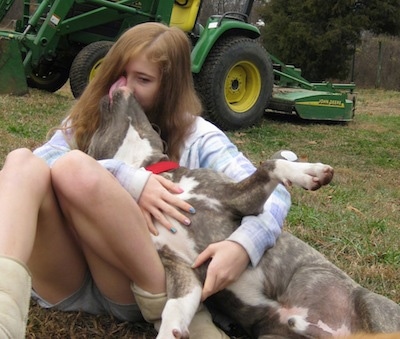
Positive reinforcement does not just mean you toss the dog a treat. Giving affection is another way to positively influence your dog to do something good.
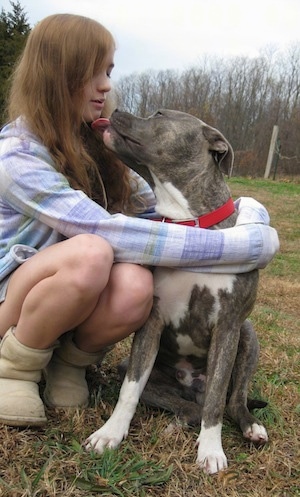
You don't even have to hug, pet or sweet-talk the dog for it to know you are happy with it. Dogs can just feel it.
Positive reinforcement works wonderfully, but not all of the time. There are certain situations where rewarding is not going to work. Sometimes you just have to say "no."
Does your dog really understand what you want?
Here is an example: at the vet’s office when I was checking out and making my next appointment there was a lady on the bench waiting to be called back with her two Labs. The entire time I was checking out she was having a full human conversation with her dogs in a sweet voice. She was saying, "Now I want you to lie down and stay here. I have a pocket full of treats and I want you to stay here. If you stay here I will reward you and give you this treat. Now you are being good dogs. Even that other dog is being a good dog. Do you see this treat that I have? I will give this to you if you just lie down. Now when this dog passes us and leaves I need you to stay here. See this treat? If you stay here I will give you this treat."
Her talking was constant and she was popping treats into her dogs’ mouths. The dogs were staying. They were laying down staring at the treats. The dogs knew that if they stayed there, they got a treat.
When it was time for me to leave and I had to walk past her, however, her dogs jumped up and pulled towards my dog. Did that mean these dogs were bad dogs? No, it was due to miscommunication. The dogs knew they were going to be rewarded for lying down, but no one ever told them they were not allowed to get up. Telling them not to get up is what some would call "negative reinforcement" and apparently in some minds this is bad.
I am sure when I left the owner offered another treat and the dogs laid back down.
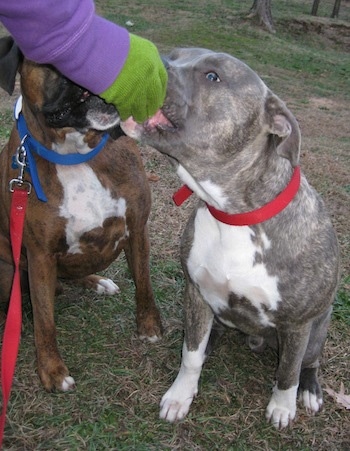
A lot of dog issues stem from owners who treat their dogs like humans, but this goes beyond that. Even human children are told "no," at least most of them are.
There are times to use positive reinforcement, but sometimes you just have to say "no" in order to complete the communication. Is this mean? Not at all. Even a mother dog disciplines her pups. In fact the mother dog is very strict with her pups, giving them limits and rules from the moment they are born. Notice I am saying discipline, not punishment. There is a big difference between guided discipline and leadership and a punishment. Dogs should not be "punished" but they do need guidance, leadership and discipline.
Positive reinforcement without guidance, leadership and discipline does not work 100% of the time because you are missing some of the communication. You tell the dog if it does this good thing I will reward you, but you never tell the dog that you do not agree with the other behavior. How is the dog to know what he is not to do if he only knows he gets rewarded for one behavior but nothing is said about the unwanted behavior? Dogs are not complex thinkers. They are very simple.
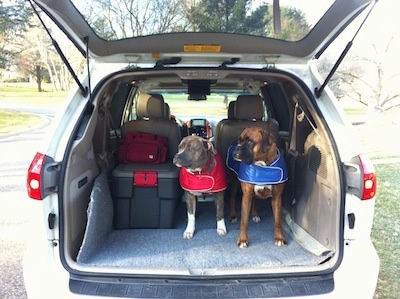
In my opinion some behaviors should not be rewarded with treats all of the time. Sometimes the behavior should just be expected, for example having the discipline to not pull me on a leash or bolt out my front door when I open it. I expect my dogs to not pull me and I expect them not to bolt. That is discipline. I say, "no, stay" and I say it like I mean it and they stay because they respect me as the one in charge.
Think about it this way: you go to a restaurant with your kids. Do you give them a piece of candy for staying in their seats every time you take them out? Most parents would answer “no, they just have to stay there because they know that is the rule when you eat out.” When your kids come home from school do you give them a reward for following the rules in school? For being polite to their teachers? I’m not sure about all parents but I expect my kids to be polite and follow the rules and I do not give them a cookie each day for doing so. Discipline need not be rewarded every time it is followed; it's about manners and respect.
One important thing to remember when using the positive reinforcement method is to be sure you do not associate a dog's bad behavior with a reward. For example, if your dog is barking at a human and you wave food in front of his nose to distract him to get him to stop, you have just associated barking at a human with a food reward. The goal is to distract the dog BEFORE it barks so you are associating the food with a human and no barking.
In sum, while I believe positive reinforcement is a wonderful thing, I also believe it should not be used all of the time in all situations. I believe in a mixture of positive reinforcement, discipline and leadership. Dogs crave leadership. They want to know the rules. You are not doing your dogs any favors by only rewarding the good, and never letting your dog know the other half of the story by asking for manners and respect.